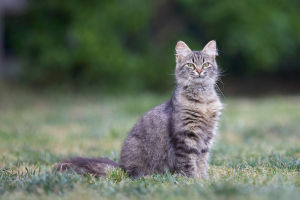Cats are enigmatic creatures with a unique way of communicating. Unlike humans, who rely heavily on verbal language, cats use their bodies to express a range of emotions and intentions.
Understanding these subtle cues can help you build a stronger bond with your feline friend and ensure their well-being. Here’s a guide to deciphering the 15 key body languages of cats:
1. Purring
- What It Means: Purring is often associated with contentment, but cats also purr when they’re in pain or feeling anxious. Circumstance is important—if your cat is purring while snuggling, it’s likely happy. If they’re purring but also showing signs of distress, they might be trying to comfort themselves.
2. Tail Up
- What It Means: A cat with a tail held high is usually confident and content. It’s a sign of a happy and approachable cat. In contrast, a tail lowered or tucked between the legs can indicate fear or submission.
3. Tail Flicking
- What It Means: A flicking tail often indicates irritation or excitement. If your cat’s tail is rapidly twitching while they’re focused on something, they might be agitated or hunting.
4. Slow Blinking
- What It Means: Slow blinking is a sign of trust and affection. Cats often give this “cat kiss” to show they feel safe and comfortable with you. You can reciprocate by blinking slowly at your cat.
5. Forward Ears
- What It Means: When a cat’s ears are pointed forward, it usually means they’re curious or interested. It’s a positive sign, suggesting your cat is engaged and alert.
6. Ears Go Back
- What It Means: Ears pulled back against the head can indicate fear, aggression, or irritation. If your cat is showing this sign, it’s best to give them space to avoid calming down.
7. Arched Back
- What It Means: An arched back, especially if accompanied by puffed-up fur, is a defensive posture. Your cat is trying to make itself look larger and more threatening to ward off perceived threats.
8. Belly Up
- What It Means: When a cat lies on its back with its belly exposed, it’s usually a sign of trust and relaxation. However, don’t assume this means they want a belly rub—many cats dislike being touched there.
9. Hissing and Growling
- What It Means: Hissing and growling are clear signs of distress or aggression. Your cat is warning you or another animal to back off. It’s important to respect these signals to avoid getting scratched or bitten.
10. Kneading
- What It Means: Kneading, where a cat pushes its paws in and out against a soft surface, is a comforting behaviour often carried over from kittenhood. It signifies that your cat is content and feels safe.
11. Tail Twitching
- What It Means: A tail twitching, especially at the tip, can indicate a cat’s heightened focus or frustration. It’s often seen when a cat is stalking prey or is mildly annoyed.
12. Grooming
- What It Means: Cats groom themselves to clean their fur and regulate their body temperature. If your cat is grooming excessively, it might be a sign of stress or health issues. Regular grooming is a positive behavior but watch for any changes in pattern.
13. Headbutting
- What It Means: Headbutting or bunting is a sign of affection and social bonding. When a cat bumps their head against you, they’re marking you with their scent and showing that they see you as a friend.
14. Licking
- What It Means: Cats lick their humans as a way to show affection or to mark their territory. If your cat is licking you, they’re likely expressing their love and trust.
15. Pawing
- What It Means: Pawing or reaching out with their paws can indicate curiosity or a desire for attention. It’s a way for cats to interact with their environment or with you.
Understanding your cat’s body language is key to fostering a deeper connection with them. By paying attention to these subtle cues, you can better interpret their needs and emotions. Remember, each cat is unique, so while these guidelines are helpful, observing your cat’s individual behaviours will provide the most accurate insights into their feelings and desires.


